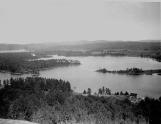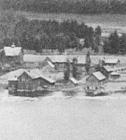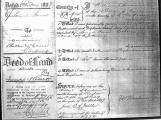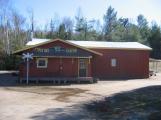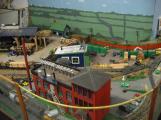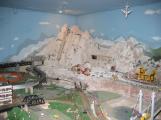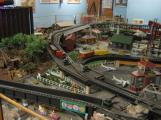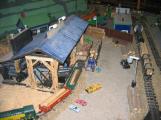10
James & Elizabeth Reid arrived in Combermere from Admaston Twp., Ferguslea, ON. His father Ephraim, was a descendant of Scottish weavers and emigrated to Ferguslea and started a woollen mill there. James and Elizabeth went up the Madawaska River and picked a location in Combermere to establish their own mill. It was near Millerís Post office and St. Paulís Anglican Church where the fire station is now located. James was born in Paisley, Scotland in 1845. Elizabeth was born July 1850 in Admaston Twp. The Reidís had 8 children - Jane, Marion, Elizabeth, Phoebe, Lorne Ephraim, John F., Ross and Louis.They constructed a mill for the processing of the local farmers wool. James died before April 1891, leaving Elizabeth and their children to carry on the business.
By the turn of the century, Elizabeth decided to move the business to Bancroft where railway access was close by. The business was outfitted with the machinery from Combermere.
Lorne Reid, son of Elizabeth, operated the Bancroft mill which was located beside another woollen mill operated by David Fuller. Around 1905, a fire took out the gristmill, flour mills, power station and two woollen mills along the York River. The fire changed the course of their lives. Elizabeth moved to Toronto and Lorne built a new General Store in partnership with Frank Thompson on Bridge Street in Bancroft.
Elizabeth died in 1914 and her body was interred beside James in Ferguslea.
11
In the late 1800ís and early 1900ís, Combermere had a thriving grist mill for grinding farmers grain into flour. Farmers came to this facility from a wide area to have this work done. Before that, farmers in the mid 1800ís would have to travel to Eganville to have the work done. Rockingham also had a gristmill on the Rockingham Creek in the mid to late 1800ís and was owned and operated by William Watson, founder of the village.The Combermere gristmill was located on what is known today as Farmers Road and operated by the Cone family.
13
On May 5, 1897, The Combermere Cheese and Butter Company received a deed from Samuel Farmer who was given the land in 1895 as a free grant from the Crown. It would appear from the document that Samuel & Catherine Farmer along with N. E. James were partners and/or owners of the Company. William Boehme was the witness to the signatures and John E. H. Miller was the Commissioner for taking affidavits. The local farmers brought their milk to the factory and shared in the profits of the business when the butter and cheese products were sold.Edward & Catherine (de Hueck) Doherty of New York came to dwell on this same land in May 1947 and their first building (where the remains of cheese and butter company was located) became known as Madonna House.
This cheese factory was one of two known to exist in the area in the late 1890ís and into the early 1900ís.
The other factory was located on Centreview Rd. in the valley just past Whitley Rd. on the right side of the road in the bush. It was known as the Bangor Butter & Cheese Company. It is believed to have started in 1896 and lasted until 1907.
In 1897, the value of the cheese sold was $2324.28 and by 1902 it had risen to $4,017.35. In 1907, the officers of the Company were: George Hoare - President and Salesman, Secretary, Treasurer and George D. Oram - Cheesemaker. Directors were John Boyle, Joseph Long, Robert McMahon, Andrew James, Enoch James and Peter Dupuis. There were many other farmers and settlers who owned shares in 1906/07.
The factory building was quite the building. It was 30í wide and 40í long. It was comprised of board and batten siding on stone piers with floor beams 12" x 12" pine framed in timber. It had a platform at the front where milk was unloaded and had a tank close to the door for emptying the milk into. There were 2 vats - one on each side 6-8 feet across and 18-20 feet long. The roof had quite a steep pitch to it. At the corner there was a boiler 12í long and was fired with 4í wood. The boiler remained after the building was torn down until scrap dealers took it away. The boiler was used for heating water for the factory and water was pumped from the local creek by injector pressure. Steam was used to make milk into cheese. A separate icehouse at the back behind the building was 20íx 26í. The factory had a cheese press that many described as 'quite the machine'. Cans of milk came in twice a day, put on a scale, weighed and stamped with the owners name. The butter and cheese was sold in Combermere, Craigmont and to local settlers in Bangor. Ice came from White Duck Lake and James Lake. The factory was not operational in the winter as there was no insulation in the walls and ceiling of the building.
There was a distinct decline in milk coming into the factory and the product being sold in the 1907 and 1908 period. The most feasible reason for both factories decline was due to the lack of enough milk to operate at a profit, and the lack of places to sell the cheese.
15
A local resident Klaas Staal, has always been interested in model trains. Many years ago he set up a small display in his home. But he soon outgrew the space.Klaas had a workshop building near his home on Combermere Rd and decided to set up a display there. It wasnít very long when his idea became a reality. Over the past 10 years the display has grown several times and now his exhibit totals over 1,000 sq ft of display. He can operate up to 4 trains at a time (S guage type). It is probably one of the best model train exhibits a visitor can see anywhere. All of the scale buildings are made by Klaas and there is even a working sawmill, working coal mine, working restaurant sign, working chair lift on a ski hill. Visitors come from all over to enjoy this wonderful exhibit. Klaas has other volunteers helping to expand the exhibit and operate the trains for visitors. There are many railway artifacts, photos and stories of railway life in the 1890-1960 era displayed in the building.
In 2012, the exhibit name was changed to 'Hydeís Bay Model Train Museum' and became a member of the Renfrew County Museum Network (22 museums) joining Mission House Museum and Gallery and Madonna House Pioneer Museum from Combermere.
21
In the early part of the 1900ís, Combermere was a thriving community. It had three churches, public school, couple of general stores, butter and cheese factory, sawmill, cedar shingle manufacturing plant, a few steamer boats, two hotels including taverns, telephone exchange, grist mill, two blacksmith shops, woollen mill and post office. For the entertainment of residents, farmers, miners and lumbermen, there was a sulky racetrack. It was located at the south-east corner of the Palmer and Rockingham Roads. Everyone enjoyed watching the races and it became quite famous in the Madawaska Valley. Was there any betting going on at that time? The current owner of the property says he can still see the curved corners in the ground of the track. Several local older people can still remember seeing the white guard rails of the track. The closest other race track at that time was in Brudenell.22
In 1967 as part of various centennial projects in the area, it was decided to honour Bailey and David Adrianís log house for future generations. Their home was located on Combermere Road approximately where the post office and Inn Town Restaurant are currently located.The building was disassembled log-by-log and reassembled on a hill just behind where the old Wendish Methodist Church had been for over 100 years. The church had been demolished in the early 1960ís. The Boehme family gave the property to the Township of Radcliffe (now Madawaska Valley) for this structure to be erected. At first the building was a local museum named 'Adrain Museum'. That didnít last very long. Many of the local craft women wanted a place to display their handicrafts and sell them to visitors during the summer months. The building is now named 'Combermere Cabin Gallery of Crafts'. Proceeds from the business go to local charitable groups as per the agreement with the Boehme family.
It is a very popular tourist attraction and the crafters volunteer their time to sell their products.
